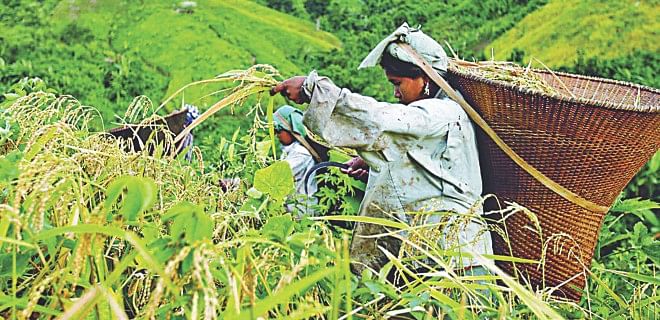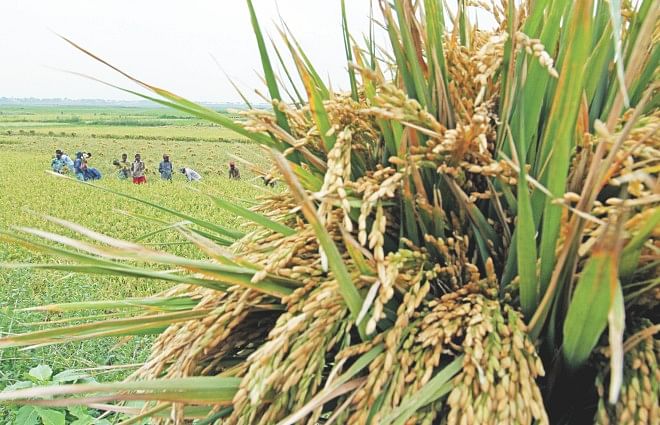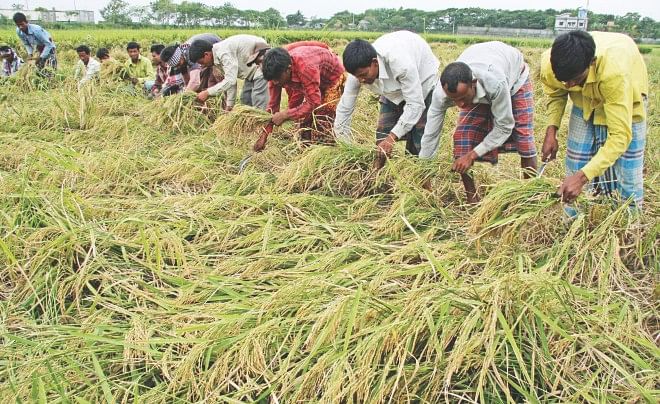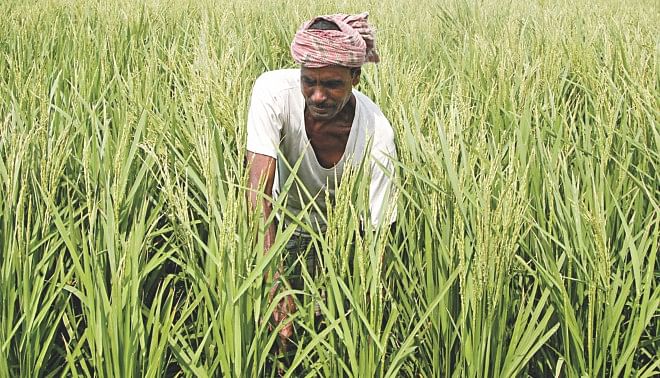Growing rice under stress environment

Global temperature is increasing gradually. IPCC (Intergovernmental Panel Climate Change on Change) says that temperature would increase from 1.8 to 4.0°C by the next 100 years. Therefore, the earth is in a process of major ecological change. The polar ice and water towers (glaciers) are in the process of melting, too. The countries along the tropical and the sub-tropical belt at the sea level are at stake right now. The existing fragile environments would be harsher in the near future. The Bay of Bengal might claim almost 17% land of Bangladesh. So the coastal zones and the low-lying areas of the country are at risk. The saline water zone is coming up several hundred kilometers away from the sea. The seasonal water bodies might turn into permanent ones to squeeze out their potential as rice growing areas. In addition, the frequency of severe flood and drought is expected to increase at an alarming rate. Despite the overall warming effect, it is evident from many of the studies, that winters are getting colder in some months. Therefore, extreme temperatures along with some other extreme climactic events are expected to visit us frequently. Accordingly, IPCC has suggested to device mitigation and adaptation strategies with respect to crop production strategies of our own to get rid of these afflictions. Rice is the strategic food crop of Bangladesh. Despite the substantial increase in production, many challenges are ahead of us to achieve the sustainability in rice production. Very lately, Food and Agriculture Organization of the United Nations (FAO) has drafted a Rice Strategy for Sustainable Food Security in Asia and the Pacific Region. This strategy is automatically implied to Bangladesh also. In fact BRRI (Bangladesh Rice Research Institute) and other institutes all over the world are quite aware of the situation described therein. The institute is already in the process of developing varieties of cultural practices adaptable to fragile environments.
Stress environments
Flood (50%), drought (20%) and salinity (30%) are the main stress environments in Bangladesh where rice frequently suffers from considerable shock to maintain its full yield potential. The nature and extent of these environments vary with season, topography and location. Flash flood, a kind of stress situation, may incur heavy damage to transplanted Aman rice at its early vegetative stage. A similar kind of flood may occur from the heavy downpour in the up stream of a Haor area to submerge the Boro rice at the maturity stage. Sometimes, flood recedes quite late to affect both transplanted Aman as well as subsequent crops. Extreme temperature (high and low) may also be a problem in some areas of the country. However, these odd environments are described hereunder.
Drought
Drought occurs mainly due to uneven distribution of rainfall. Northwestern part of Bangladesh is treated as a drought-prone area for poor rainfall. It is one of the major abiotic constraints for rice grown (5.7 m ha) under rain-fed conditions in Bangladesh and causes a substantial reduction of yield. It is a common feature that appears to affect a rice crop in any of the growth stages (early drought). Transplanted Aman (T. Aman: Rainfed lowland rice) cultivators usually suffer from water stress at reproductive (Terminal drought) and/or early ripening phases to incur heavy loss to crop yield. Upland rice (Aus) also suffers from drought, as the crop is dry seeded and grown under rainfed conditions. The impact of drought depends not only on the duration and intensity but also on the nature of crop along with its stage of growth and soil characteristics. The drought management strategies are mentioned below.

Drought escaping strategy: BRRI scientists identified drought risks of varying intensities for medium duration (140 days) varieties. Transplanting between 5 July to 25 July might have a less risk of encountering drought. Short duration (120-day) rice varieties like BRRI dhan33 and BRRI dhan39, BINA 7 could avoid the terminal drought if they are transplanted by 15 July in the drought prone area. Some of the varieties like BRRI dhan56, BRRI dhan57, BRRI dhan62 can be grown within 100-110 days in order to escape drought. After harvesting these crops by mid-November, farmers can go for wheat and then mungbean cultivation. Therefore T. Aman (short duration)-Wheat-Mungbean is an adaptable cropping pattern in a drought prone area.
Drought mitigation: The potentiality of T. Aman rice would be increased up to 30% provided the crop is satisfied with a supplemental irrigation. This could be done by BRRI designated rainwater harvesting reservoir having the size of 4-5% of the command area (2 m deep with 2:1 side slope).
Alternate wet and dry method: A rice field does not need standing water throughout the growth period. The field during the vegetative stage could be kept free of water for some days to save water. The days without water depends on the soil characteristics, weather and plant growth stages. All these cumulative affects in terms of water depth is monitored through an observation pipe. At least, this method saves 30% water compared to the ordinary method.
Cultivars adaptable dought prone area: The upland rice varieties are mostly of land race origin, called Aus, directly sown in dry field conditions having moisture only up to field capacity or some times less than that. The seeding time is April-May. Little rain is available this time. However, due to April nor'westers (Kal-Boishakhi) we might have some rain at this time, which is good for the establishment of this crop. If there is no rain, the Aus rice could be dry seeded in a cultivated field and kept underneath the soil for a month or so, just waiting for the rain. This is a traditional practice called "Khorani" in Bangla. This Aus rice has some tolerance to drought and could withstand a jolt of drought during the month of Jaisthay (May). If there is rain in June the crop could recover soon and yield a reasonably good harvest. The yield potentiality of these varieties is quite low. Therefore, the BRRI scientists developed some varieties like BR20, BR21, BR24, BRRI dhan42 and BRRI dhan43 to be used as Aus or upland varieties. These varieties have some tolerance to avoid water stress through elongated roots. Unfortunately, this eco-friendly type of rice culture has lost its area significantly to irrigated rice culture.
We have a good number of T. Aman varieties like BR4, BR10, BR11, BRRI dhan30, BRRI dhan31, BRRI dhan32, BRRI dhan33, BRRI dhan44, BRRI dhan46, BRRI dhan49 etc. Unfortunately, these varieties are not tolerant to drought. However, some photoperiod insensitive varieties like BRRI dhan33, BRRI dhan39, might escape the terminal drought due to their short growth duration. BRRI dhan56 and BRRI dhan57 have recently been recommended as drought tolerant varieties.
Flood
Flood may be of different types with respect to ecotype e. g. flash flood, late flood, water logging (resultant effect of flood or rainfall) etc. Crop submergence due to flood or flash flood is an important hazard to the agriculture of Bangladesh related to climate change. Bangladesh has a total area of 14.8 million hectares. Out of this area, 70% is affected by different types of flash floods which are- 1) flash floods caused by hilly rivers in the north-eastern region of the country, 2) flash floods caused by drainage congestion due to construction of unplanned infra-structure, 3) monsoon floods caused by major rivers in flood plains of the country, and 4) coastal floods caused by tidal submergence and cyclone surges. In Bangladesh, about 1 million hectare of cropland is highly flood prone and 5 million hectares moderately prone. More than 18 districts of Bangladesh are more or less regularly affected by different grades of flash floods.

Flash flood: Flash floods regularly affect rainfed lowland rice ecosystems. About 2.6 m hectare rice lands of Bangladesh is affected by excess water for incessant rainfall in Monsoon season and periodically suffer from flash floods with complete submergence for 1-2 weeks or more covering about 24% of the total rice areas. This flood causes enormous damage to rice crop and irreparable yield loss (10-100%) depending on water depth, duration of submergence, turbidity of water, light intensity and age of the crop, etc. The flash flood is another concern for Boro rice in Haor area. Therefore, we need a rice variety having short growth duration with higher yield. As a short-duration-variety BRRI dhan28 and BRRI dhan45 are the suitable options. Earlier establishment of these short duration varieties pushed the crop in its reproductive phases in February's low temperatures to incur low temperature injury. BRRI dhan29 with the highest yielding ability is very popular even in the haor area risks. But this variety is prone to flash flood damage due to its longer growth duration. The flash flood generally occurs in late April. Submergence at maturity might affect grain yield severely. Seedling age is positively related to growth duration. More so the seeding time has significant impact on the growth duration of the crop. Therefore by manipulating cultivar, seeding time and seedling age we could easily have our safe harvest prior to the flash flood.
Cultivars adaptable to submergence due to flash flood: T. Aman crop suffers from submergence just after seedling establishment in many parts of the country. This is due to the erratic nature of the flood. For tidal submergence prone area BRRI has a variety (BRRI dhan44), quite acceptable by many of the farmers of the concerned area. To cope up with the submergence situation, genotype like BR11Sub1, and some of its near isogenic lines have been developed by BRRI scientists using conventional breeding methods as well as biotechnological and physiological tools. The other submergence tolerant lines were also under consideration. Out of these lines BR11 Sub1 and Swarna Sub1 lines have been very recently released as BRRI dhan51 and BRRI dhan52, respectively. Recently BINA has also released some more submergence tolerant varieties.
Monsoon flood: Late recession of monsoon flood affects a rice cropping system seriously. We have varieties like BR22, BR23, and BRRI dhan46 to establish crops as late transplanted Aman appropriate for the environment where floodwater recedes late or early crop is damaged due to flash flood. These varieties are highly photoperiod sensitive, so they could flower prior to the onset of cold and even drought sometimes at the reproductive stage. .
Amazingly, for deep-water environment and water stagnant condition we do not have any high yielding variety. We have two kinds of DWR environment. One is shallow, good for varieties adapted to 50 cm or little more water depth. Another is floating rice good for growing in an environment having water depth from 1 m to 3m. However some sporadic work is going on to develop some DWR for shallow environment. But the achievement is not significant. In contrast, some research activities are in progress with the objective to develop a variety for water stagnant conditions. The work is still at the initial stage. Only a few breeding lines have been identified as genotype tolerant to stagnant conditions. Prior to having a variety up to satisfactory level, BR23 could be considered as variety tolerant to water stagnant also. More so, this variety has some tolerance to salinity also. That is the reason why the variety is quite popular in some parts of Satkhira as well as Khulna.
Agronomic management for submergence shock: Regarding management options, top dressing of urea and potassium around 10 days after receding flash flood followed by weeding and washing the leaves is recommended for better recovery. Potassium application as 50% basal + 25% after desubmergence + 25% at 5 days before panicle initiation is quite effective.
Salinity
Out of 2.85 million hectares of coastal and off-shore land, about 1 million hectare is affected by varying degrees of salinity. These coastal saline soils are distributed unevenly in 64 upazilas of 13 coastal districts covering portions of 8 Agro Ecological Zones (AEZ). The larger portion of saline land (0.65 million ha) exists in the districts of Satkhira, Khulna, Bagerhat, Barguna, Patuakhali, Pirojpur and Bhola on the western coast and the smaller portion (0.18 mha) in the districts of Chittagong, Cox's Bazar, Noakhali, Laxmipur, Feni and Chandpur on the eastern coast. Electrical conductivity of the saturation extract of the top soil in the saline zone varied from 1-20 dS/m, while in non saline zones it was 0.68-1.59 dS/m.
Coastal lands of Bangladesh are affected by varying degrees of salinity. About 1.02 million hectares in the coastal areas are affected by various degrees of salinity. Very slight salinity (2.0-4.0 dS/m) exists about 0.287 m ha, slight salinity (4.1 - 8.0 dS/m) in 0.426 m ha, moderately salinity (8.1-16.0 dS/m) in 0.08 m ha, strong salinity (>16.0 dS/m) in 0.04 mha. The salinity varies with season. In dry season soil and river water salinity increase, while during the monsoon season, it goes down. Therefore land use has temporal and spatial variations with season.
Salinity management
Cultural methods
Winter is relatively short in the coastal region. So the establishment of Boro a month earlier might help to avoid higher salinity during April-May. Straw mulching conserves water and reduces capillary rise of saline water and prevents forming saline crust. Soil flashing (washing soil with fresh water) for four times is good for reducing soil salinity from 4 dS/m to 0.49 dS/m During Boro, one time flashing during reproduction phase is quite useful for the crop.
Integrated fertilizer management is quite beneficial for a growing drop in a saline prone area. Dibbling rice seeds in Aus season help to avoid direct contact of seedling with saline crust at the upper layer of the soil. Cultivation of Dhaincha as a crop in T. Aman-Fallow cropping pattern to reduce capillary movement of salty water through evaporation. Some other strategies are as follows:
- Erection of embankments along the rivers. The height of the embankment should be sufficiently high to protect water intrusion during full moon or new moon.
- Embankments should be quipped with sluice gates at every convenient place to drain out excess water and wash out salt crusted tops during March and April with monsoon rain.
- The land should be even to prevent capillary rise of salt water at the higher elevation of the land.
- Monsoon rain water should be harvested in the canal, ditches and blocked rivers to irrigate during dry period.
- Making high (25-30 cm) ails to store rain to protect saline increase (through capillary rise too) due to drought.
- Salinity level between 2-4 dS/m during dry period deserves careful soil and water management to maintain a saline tolerant rice cultivar.
- Cultivate fallow land to cultivate during summer to protect from soil cracking to prevent soil crusting by evaporation.
- Fertilization of Gypsum and Potash helps to reduce salinity.

Others climate adversaries
Extreme temperatures are destructive to plant growth and development. The critically average low and high temperatures, normally below 20⁰C and above 30⁰C, vary from one growth stage to another. These critical temperatures differ according to variety, duration of critical temperature, diurnal changes, and physiological status of the plant. The critical temperature estimated for BRRI dhan28 at the agronomic panicle initiation for night and day temperatures are 12 and 28⁰C, respectively. The corresponding temperatures for booting stage are 13 and 29⁰C. This estimation is done for BRRI dhan28 based on some experiments and assumptions.
When rice is exposed higher than 35⁰C for more than 1 hour, injuries occur according to growth stages. Spikelet sterility in Bangladesh, generally occurs in Early Aus season (March-June) and sometimes in transplanted Aman season (June-October) when temperature exceeds this critical bar and stays for 1 hour during anthesis. Late Boro season (January-May) may also induce spikelet sterility to affect grain yield. The situation aggravates as the humidity during high temperature is low.
Despite its seeding time in November, farmers in the Haor area are compelled to sow their seed in October. This early seeded and transplanted Boro crop suffers from low temperature at the reproductive phase. Conversely, the late established Boro as practiced in North Bengal and elsewhere may encounter critical maximum (day) temperature (≥35°C) at the booting or at the flowering stage due to older seedling or late seed bed preparation. The encounter during flowering, even for a short time, is a decisive factor to yield severe sterility to the crop.
Pest infestation
Global warming has significant impact on the pest incidence on rice. Some of the minor pests become major. Some of the major pests have intensified their activities. Minor False smut is becoming major day by day. The intensity of Sheath blight, Bacterial leaf streak, Blast etc. is in increasing trend. Same is the case with insect pests also. The minor gal midge, a minor insect, is increasing significantly
in many parts of the country. The resurgence of BPH is quite common both in Boro and T. Aman.
Pest control strategy
Scientists are trying to develop pest control methods both chemically and biologically. The better way is to develop a variety tolerant to pest. We have some varieties like this. BRRI dhan35 is resistant to BPH. BRRI dhan55 is tolerant to some major diseases and insect pests. BRRI has developed 65 varieties (including 4 hybrids) to cultivate all over the country. It is very difficult to develop a variety with multiple resistances. But gene pyramiding is a method to develop a variety with this kind of resistance. Our scientists are in the process of developing variety with multiple resistances both against the biotic as well as abiotic stresses.
These are the outcomes so far BRRI has achieved against the stress ecosystems. Even then, these achievements are not enough to satisfy the vast need of the country. So BRRI is consistently in the process of refinement of their innovations with respect to different stress environments to make the technology more farmer friendly as well as eco-friendly. More so, BRRI has to develop some more varieties tolerant to cold at the reproductive stage for Haor area. Even varieties tolerant to high temperature suitable for late Boro and early Aus is expected. Even suitable variety for deep water ecosystem is also an expectation from some of the areas of the country.
Some issues under considerations
Recently BRRI scientists are in the process of reshaping their work on the issues like high yield per day, breaking yield ceiling, nutritious rice, eco and farmers' friendly cultural practice, crop diversification, rice heritage, climate smart rice varieties, rain fed rice agriculture, on-farm water management, conservation tillage, farm mechanization and post-harvest technology, value addition in rice, maintenance of bio-diversity, ICT application in Agriculture, Biological pest management strategy etc. to the fragile environment of the country. Many of the issues appear to be old, but I swear the approach has to be quite innovative.
The author is director general (Current Charge), Bangladesh Rice Research Institute.

 For all latest news, follow The Daily Star's Google News channel.
For all latest news, follow The Daily Star's Google News channel. 



Comments